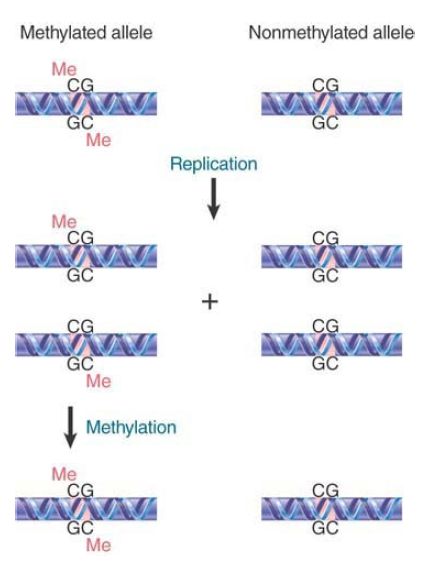


 النبات
النبات
 الحيوان
الحيوان
 الأحياء المجهرية
الأحياء المجهرية
 علم الأمراض
علم الأمراض
 التقانة الإحيائية
التقانة الإحيائية
 التقنية الحيوية المكروبية
التقنية الحيوية المكروبية
 التقنية الحياتية النانوية
التقنية الحياتية النانوية
 علم الأجنة
علم الأجنة
 الأحياء الجزيئي
الأحياء الجزيئي
 علم وظائف الأعضاء
علم وظائف الأعضاء
 الغدد
الغدد
 المضادات الحيوية
المضادات الحيوية|
Read More
Date: 28-12-2015
Date: 5-5-2016
Date: 24-5-2021
|
Introduction to Epigenetics
Key concept
- Epigenetic effects can result from modification of a nucleic acid after it has been synthesized with no change in the primary DNA sequence or by the perpetuation of protein structures.
Epigenetic inheritance describes the ability of different states, which may have different phenotypic consequences, to be inherited without any change in the sequence of DNA. This means that two individuals with the same DNA sequence at the locus that controls the effect may show different phenotypes. The basic cause of this phenomenon is the existence of a self-perpetuating structure in one of the individuals that does not depend on the DNA sequence. Several different types of structures have the ability to sustain epigenetic effects:
-A covalent modification of DNA (methylation of a base)
-A proteinaceous structure that assembles on DNA
-A protein aggregate that controls the conformation of new subunits as they are synthesized
In each case the epigenetic state results from a difference in function that is determined by the structure. In the case of DNA methylation, a gene methylated in its control region may fail to be transcribed, whereas an unmethylated version of the gene will be expressed (this idea is introduced in the Eukaryotic Transcription chapter). FIGURE.1 shows how this situation is inherited. One allele has a sequence that is methylated on both strands of DNA, whereas the other allele has an unmethylated sequence. Replication of the methylated allele creates hemimethylated daughters that are restored to the methylated state by a constitutively active DNA methyltransferase (DNMT). Replication does not affect the state of the unmethylated allele. If the state of methylation affects transcription, the two alleles differ in their state of gene expression, even though their sequences are identical.

FIGURE .1 Replication of a methylated site produces hemimethylated DNA, in which only the parental strand is methylated. A perpetuation methylase recognizes hemimethylated sites and adds a methyl group to the base on the daughter strand. This restores the original situation, in which the site is methylated on both strands. An unmethylated site remains unmethylated after replication.
Self-perpetuating structures that assemble on DNA usually have a repressive effect by forming heterochromatic regions that prevent the expression of genes within them. Their perpetuation depends on the ability of proteins in a heterochromatic region to remain bound to those regions after replication, and then to recruit more protein subunits to sustain the complex. If individual subunits are distributed at random to each daughter duplex at replication, the two daughters will continue to be marked by the protein, though its density will be reduced to half of the level before replication.
FIGURE .2 shows that the existence of epigenetic effects forces us to the view that a protein responsible for such a situation must have some sort of self-templating or self-assembling capacity to restore the original complex.

FIGURE 2. Heterochromatin is created by proteins that associate with histones. Perpetuation through division requires that the proteins associate with each daughter duplex and then recruit new subunits to reassemble the repressive complexes.
It can be the state of protein modification, rather than the presence of the protein per se, that is responsible for an epigenetic effect. Usually the tails of histones H3 and H4 are not acetylated in constitutive heterochromatin. If heterochromatin becomes acetylated, though, silenced genes in the region may become active. The effect may be perpetuated through mitosis and meiosis,which suggests that an epigenetic effect has been created by changing the state of histone acetylation.
Independent protein aggregates that cause epigenetic effects (called prions) work by sequestering the protein in a form in which its normal function cannot be displayed. Once the protein aggregate has formed, it forces newly synthesized protein subunits to join it in the inactive conformation.



|
|
|
|
التوتر والسرطان.. علماء يحذرون من "صلة خطيرة"
|
|
|
|
|
|
|
مرآة السيارة: مدى دقة عكسها للصورة الصحيحة
|
|
|
|
|
|
|
نحو شراكة وطنية متكاملة.. الأمين العام للعتبة الحسينية يبحث مع وكيل وزارة الخارجية آفاق التعاون المؤسسي
|
|
|